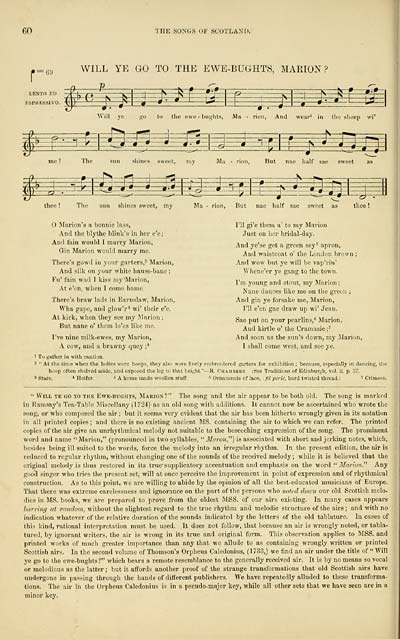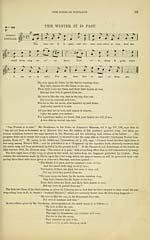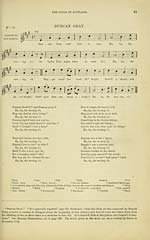Glen Collection of printed music > Printed music > Wood's edition of the songs of Scotland
(84) Page 60 - Will ye go to the ewe-bughts, Marion
Download files
Complete book:
Individual page:
Thumbnail gallery: Grid view | List view

60
TI1K KUN'liS OIT SCOT LAX l>.
p = cj
KSI'KKHSIVO.
l
WILL YE GO TO THE EWE-BUGHT.S, MARION?
^B^S
$
BE
Will ye go to the ewe - bughts, Ma - rion, And wear' in the sheep wi'
I
-&-
S^feS
£
3 F^=F
tfr*
33EF
«-#-
me? The sun shines sweet, my Ma - rion, But nae half sae sweet as
I
22
:tt
ii3g^=rs
3=*
m^s
5
thee ! The sun shines sweet, my
Ma - rion, But nae half sae sweet as thee !
Marion's a bonnie lass,
And the blythe blink's in her c'e;
Ami fain would I marry Marion,
Gin Marion would marry me.
There's gowd in your garters, 2 Marion,
And silk on your white hause-baue ;
Fu' fain wad 1 kiss my 'Marion,
At e'en, when I conic hame.
There's braw lads in Earnslaw, Marion,
Wha gape, and glow'r 3 wi' their e'e,
At kirk, when they sec my Marion ;
But nane o' them lo'es like me.
I've nine milk-ewes, my Marion,
A cow, and a brawny qney ; 1
' To gather in with caution.
,J " At tho timo when the Indies were hoops, they also wore finely
hoop often sholvod aside, and exposed the leg to that height.'
s Stare. * Heifer. * A home-tnudo woollen Btuff.
I'll gi'e them a' to my Marion
Just on her bridal-day.
And ye'se get a green scy 6 apron,
And waistcoat o' the London brown :
And wow but ye will be vap'rin'
Whene'er ye gang to the town.
I'm young and stout, my Marion :
Nane dances like me on the green ;
And gin yc forsake me, Marion,
I'll e'en gae draw up wi' Jean.
Sao put on your pearlins, Marion,
And kirtle o' the Cramasie :'
And soon as the sun's down, my Marion,
I shall come west, and see ye.
embroidered garters for exhibition ; because, especially in dancing, the
' — It. Chamdkbs. (See Traditions of Edinburgh, vol. ii. p. 57.
1 Ornaments of lace, [Jil pcrU, hard twisted thread.) 7 Crimson.
" Wnx ye go to THE KwK-nuanTS, Marion?" The song and the air appear to be both old. The song is marked
in Kamsay's Tea-Table Miscellany (1724) as an old song with additions. It cannot now be ascertained who wrote the
song, or who composed the air ; but it seems very evident that the air has been hitherto wrongly given in its notation
in all printed copies ; and there is no existing ancient MS. containing the air to which we can refer. The printed
copies of the air give an unrhythmical melody not suitable to the beseeching expression of the song. The prominent
word and name " Marion," (pronounced in two syllables, " Maron") is associated with short and jerking notes, which,
besides being ill suited to the words, force tho melody into an irregular rhythm. In the present edition, the air is
reduced to regular rhythm, without changing one of the sounds of the received melody; while it is believed that the
original melody is thus restored in its true- supplicatory accentuation and emphasis on the word " Marion." Any
good singer who tries the present set, will at once perceive the improvement in point of expression and of rhythmical
construction. As to this point, we are willing to abide by the opinion of all the best-educated musicians of Europe.
That there was extreme carelessness and ignorance on the part of the persons who noted down our old Scottish melo-
dies in MS. books, we are prepared to prove from the oldest MSS. of our airs existing. In many cases appears
barring at random, without tho slightest regard to the true rhythm and melodic structure of the airs ; and with no
indication whatever of tho relative duration of the sounds indicated by the letters of the old tablature. In cases of
this kind, rational interpretation must be used. It does not follow, that because an air is wrongly noted, or tabla-
tured, by ignorant writers, the air is wrong in its true and original form. This observation applies to MSS. and
printed works of much greater importance than any that we allude to as containing wrongly written or printed
Scottish airs. In the second volume of Thomson's Orpheus Caledonius, (1733,) we find an air under the title of " Will
ye go to the ewc-bughts?" which bears a remote resemblance to the generally received air. It is by no means so vocal
or melodious as the latter ; but it affords another proof of the strange transformations that old Scottish airs have
undergone in passing through the hands of different publishers. We have repeatedly alluded to these transforma-
tions. The air in the Orpheus Caledonius is in a pseudo-major key, while all other sets that we have seen are in a
minor key.
TI1K KUN'liS OIT SCOT LAX l>.
p = cj
KSI'KKHSIVO.
l
WILL YE GO TO THE EWE-BUGHT.S, MARION?
^B^S
$
BE
Will ye go to the ewe - bughts, Ma - rion, And wear' in the sheep wi'
I
-&-
S^feS
£
3 F^=F
tfr*
33EF
«-#-
me? The sun shines sweet, my Ma - rion, But nae half sae sweet as
I
22
:tt
ii3g^=rs
3=*
m^s
5
thee ! The sun shines sweet, my
Ma - rion, But nae half sae sweet as thee !
Marion's a bonnie lass,
And the blythe blink's in her c'e;
Ami fain would I marry Marion,
Gin Marion would marry me.
There's gowd in your garters, 2 Marion,
And silk on your white hause-baue ;
Fu' fain wad 1 kiss my 'Marion,
At e'en, when I conic hame.
There's braw lads in Earnslaw, Marion,
Wha gape, and glow'r 3 wi' their e'e,
At kirk, when they sec my Marion ;
But nane o' them lo'es like me.
I've nine milk-ewes, my Marion,
A cow, and a brawny qney ; 1
' To gather in with caution.
,J " At tho timo when the Indies were hoops, they also wore finely
hoop often sholvod aside, and exposed the leg to that height.'
s Stare. * Heifer. * A home-tnudo woollen Btuff.
I'll gi'e them a' to my Marion
Just on her bridal-day.
And ye'se get a green scy 6 apron,
And waistcoat o' the London brown :
And wow but ye will be vap'rin'
Whene'er ye gang to the town.
I'm young and stout, my Marion :
Nane dances like me on the green ;
And gin yc forsake me, Marion,
I'll e'en gae draw up wi' Jean.
Sao put on your pearlins, Marion,
And kirtle o' the Cramasie :'
And soon as the sun's down, my Marion,
I shall come west, and see ye.
embroidered garters for exhibition ; because, especially in dancing, the
' — It. Chamdkbs. (See Traditions of Edinburgh, vol. ii. p. 57.
1 Ornaments of lace, [Jil pcrU, hard twisted thread.) 7 Crimson.
" Wnx ye go to THE KwK-nuanTS, Marion?" The song and the air appear to be both old. The song is marked
in Kamsay's Tea-Table Miscellany (1724) as an old song with additions. It cannot now be ascertained who wrote the
song, or who composed the air ; but it seems very evident that the air has been hitherto wrongly given in its notation
in all printed copies ; and there is no existing ancient MS. containing the air to which we can refer. The printed
copies of the air give an unrhythmical melody not suitable to the beseeching expression of the song. The prominent
word and name " Marion," (pronounced in two syllables, " Maron") is associated with short and jerking notes, which,
besides being ill suited to the words, force tho melody into an irregular rhythm. In the present edition, the air is
reduced to regular rhythm, without changing one of the sounds of the received melody; while it is believed that the
original melody is thus restored in its true- supplicatory accentuation and emphasis on the word " Marion." Any
good singer who tries the present set, will at once perceive the improvement in point of expression and of rhythmical
construction. As to this point, we are willing to abide by the opinion of all the best-educated musicians of Europe.
That there was extreme carelessness and ignorance on the part of the persons who noted down our old Scottish melo-
dies in MS. books, we are prepared to prove from the oldest MSS. of our airs existing. In many cases appears
barring at random, without tho slightest regard to the true rhythm and melodic structure of the airs ; and with no
indication whatever of tho relative duration of the sounds indicated by the letters of the old tablature. In cases of
this kind, rational interpretation must be used. It does not follow, that because an air is wrongly noted, or tabla-
tured, by ignorant writers, the air is wrong in its true and original form. This observation applies to MSS. and
printed works of much greater importance than any that we allude to as containing wrongly written or printed
Scottish airs. In the second volume of Thomson's Orpheus Caledonius, (1733,) we find an air under the title of " Will
ye go to the ewc-bughts?" which bears a remote resemblance to the generally received air. It is by no means so vocal
or melodious as the latter ; but it affords another proof of the strange transformations that old Scottish airs have
undergone in passing through the hands of different publishers. We have repeatedly alluded to these transforma-
tions. The air in the Orpheus Caledonius is in a pseudo-major key, while all other sets that we have seen are in a
minor key.
Set display mode to: Large image | Transcription
Images and transcriptions on this page, including medium image downloads, may be used under the Creative Commons Attribution 4.0 International Licence unless otherwise stated. ![]()
| Special collections of printed music > Glen Collection of printed music > Printed music > Wood's edition of the songs of Scotland > (84) Page 60 - Will ye go to the ewe-bughts, Marion |
|---|
| Permanent URL | https://digital.nls.uk/91338751 |
|---|
| Description | Scottish songs and music of the 18th and early 19th centuries, including music for the Highland bagpipe. These are selected items from the collection of John Glen (1833 to 1904). Also includes a few manuscripts, some treatises, and other books on the subject. |
|---|
| Description | The Glen Collection and the Inglis Collection represent mainly 18th and 19th century Scottish music, including Scottish songs. The collections of Berlioz and Verdi collected by bibliographer Cecil Hopkinson contain contemporary and later editions of the works of the two composers Berlioz and Verdi. |
|---|

